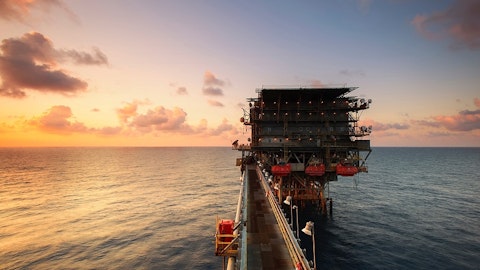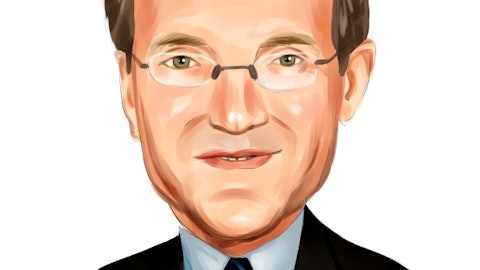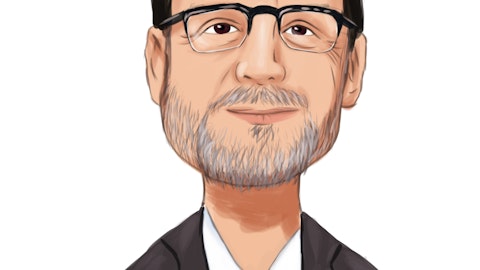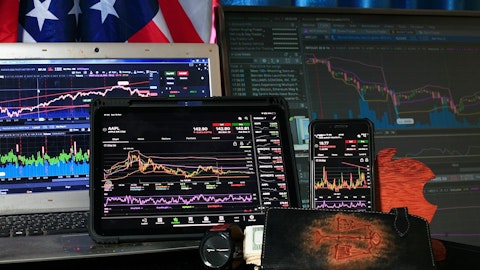Ardmore Shipping Corporation (NYSE:ASC) Q4 2023 Earnings Call Transcript February 15, 2023
Bryan Degnan: Good morning, everyone. Welcome to Ardmore Shipping’s 2023 Investor Day, during which we will also be covering the Company’s results for the Fourth Quarter and Full-Year 2022. I’m Bryan Degnan with the IGB Group. Just a few administrative points before we get underway today. The event is being recorded and broadly distributed via live webcast, which, along with today’s slide is accessible at www.ardmoreshipping.com. An audio replay of the event will be available on the website from later today. The standard earnings press release was issued pre-market this morning and is also available on the website. So later in the event, following prepared remarks, there will be a Q&A session, at which point, we will take questions from the people with us in the room today.
For those joining remotely, please feel free to submit any questions that you might have at any time to ardmore@ig, G as in girl, B as in boy, ir.com, so ardmore@igbir.com. Throughout the event and for the benefit of those joining remotely, we would ask that all speakers and questioners utilize the provided microphones. Slide 3 for the disclaimer here. Please allow me to remind you that our discussion today contains forward-looking statements. Actual results may differ materially from those projected in the forward-looking statements. Additional information concerning factors that could cause the actual results to differ materially from those in the forward-looking statements is contained in the fourth quarter and full-year 2022 earnings release.
Now moving to Slide 4, I would just like to briefly introduce you to the members of the Ardmore’s leadership team, and we have the pleasure of hearing from today. We have with us Curtis McWilliams, Ardmore’s Chairman; Anthony Gurnee, Founder and Chief Executive Officer; Bart Kelleher, Chief Financial Officer; and Gernot Ruppelt, Chief Commercial Officer. And with that, I would ask Curtis McWilliams, Ardmore’s Chairman, to come up for some brief opening remarks.
Curtis McWilliams: I promise they’ll be brief. On behalf of the Board of Ardmore Shipping, I’d like to welcome you to this our Annual Investor Day presentation. Now it’s been 10 years since Ardmore became a publicly listed company on the New York Exchange. Over this time, Ardmore has always been committed to the highest standards of both governance and transparency. Today’s presentation is just one element of this commitment, and I hope you will find it both interesting and informative. As you saw in our earnings release this morning, as Chair, I’m enormously pleased with our 2022 performance, not only our strong earnings performance, but as well our continued commitment to our capital allocation policy, resulting in a very, very strong balance sheet, and our reintroduction of our dividend as we return capital to our shareholders.
As you’ll hear from the team today, we continue to believe that the prospects for our sector and more especially for Ardmore, remain very bright as 2023 unfolds. In closing, I want to thank you, our shareholders, for your continued support of our company. Our focus as a Board is to ensure that Ardmore remains solely focused on the creation of sustainable long-term value for its shareholders. I truly hope that we will continue to earn your trust as a steward of your investment. And with that, I’m happy to turn over the presentation to Tony Gurnee, our CEO.
Anthony Gurnee: That was really good. I think we can just stop right there. Thanks, Curtis, and welcome, everyone. First, I’d like to outline the format of today’s call. So Bart and I are going to start off by presenting the results for the fourth quarter and full-year. We’re then going to pivot to the Investor Day part of the presentation. I’ll begin with an overview of Ardmore strategy, and then Gernot will give his high insights on the commercial side of the business before going into some details on the market outlook. And then we’ll conclude the presentation and open up the call for questions from the floor as well as remotely. And again, for remote questions, please send them to ardmore@igbir.com. Turning to Slide 6. So for highlights.
We are pleased to report our most profitable year thus far with adjusted earnings of $144 million, or $3.74 a share. Fourth quarter performance continues to reflect the strength in the product and chemical tanker markets, with adjusted earnings of $54 million or $1.30 per share, equating to an annualized book return on equity of 46%. We highlighted in the chart on the upper right of this slide, our full-year results were driven by a strong second half, which is needed into the first quarter. On a TCE basis, our MRs earned $43,175 per day for the fourth quarter. And so far, we are running at $39,500 for the first quarter of 2023 with 55% booked. Chemical tankers on a capital-adjusted basis earned $33,000 a day for the fourth quarter and are running just slightly lower at $31,300 for the first quarter with 70% booked.
These rates emphasize the ongoing robustness of the market. And in fact, if the first quarter to-date were to continue for the full-year, although they are a little bit off the highs of last year, the resulting earnings would be about $4.60 a share. As a result of the strong performance and consistent with the capital allocation policy, we are pleased to declare a quarterly cash dividend of $0.45 a share, representing one-third of adjusted earnings. Further benefit of this performance, Ardmore continues to delever and strengthen its balance sheet, resulting in lower breakeven rates, higher quality earnings and much greater substance behind our net asset value. Overall, we feel that between our operating performance and the solid financial profile, Ardmore is exceptionally well positioned to continue benefiting from this market.
One final important note on this slide, especially for those that are not fully familiar with our industry, is the operating leverage we have to charter rates were every $10,000 a day increase in rates results in an incremental $2.40 in earnings per share. So turning to Slide 7. The market outlook remains very compelling, benefiting in particular from the current oil market volatility, which, of course, has a lot to do with the Russia-Ukraine conflict. In fact, the conflict continues to drive a further pronounced and likely to be persistent, reordering of global refined product trade, resulting in increased ton-mile demand and supporting very high rates. Our first quarter to-date performance was marginally off the peak of last year, due in part to the impact of extreme weather and early refinery maintenance in the U.S. Gulf.
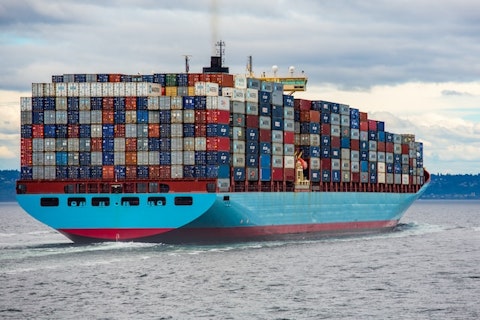
Photo by Ian Taylor on Unsplash
We believe this is now behind us with the Atlantic Basin recovering rapidly to the levels of East of Suez over the past week. So arguably, the market is back to around $40,000 to $50,000 a day on a global basis. We are also seeing China reopening and set to strengthen global economic activity and thus adding a further layer of product tanker demand, for example, for jet fuel. Meanwhile, chemical tanker demand is also forecast to expand in 2023 supported by global growth. Added to all these near-term factors are the robust underlying supply-demand fundamentals, which Gernot will discuss in more detail later on. So turning to Slide 8. We will speak more about capital allocation later, but I wanted to highlight the dividend for the fourth quarter at $0.45 a share.
The calculation is shown on the table to the right side of the slide, I’m equating to a current yield of 11%. The dividend will be paid on March 15 to all shareholders of record as of February 28. With that, I’d like to hand the call over to Bart.
Bart Kelleher: Thank you. Moving to Slide 9. So Ardmore continues to build upon its financial strength. Net leverage at the end of December stood at 25%, which is down from 55% at the start of last year. We have a very strong liquidity position with $50 million of cash on hand and $170 million of undrawn revolving facilities at year-end. As Tony mentioned earlier, we’ve reduced our cash breakeven to approximately $14,500 per day, driven by our reduced debt levels as well as our access to revolving facilities. As always, Ardmore remains focused on optimizing performance as we benefit from the positive market volatility in these elevated markets. We are also closely managing costs in this continued inflationary environment. Slide 10, for financial highlights.
As noted, we are very pleased with our performance and we report record full-year results of $3.74 per share. We are corresponding reporting strong EBITDAR for the quarter and the year and we continue to frame EBITDAR as an important comparable valuation metric against our IFRS reporting peers. So please note that there is a full reconciliation of this presented in the appendix on Slide 45. Although our very favorable floating-to-fixed interest rate swaps will roll off this summer, we are in a position to mitigate the impact of the higher interest rates due to the significantly lower debt levels. And please also note Slide 49 in the appendix has our Q1 guidance numbers as well. Moving to Slide 11. continue to reinvest in the fleet to optimize performance.
This year, we will have eights scheduled drydockings. And by the way, this reduces to four next year. In tandem with these drydockings, we are installing second-generation scrubber technology on an initial six of our vessels with the installations occurring within the time constraints of the normal drydocking. These modular units are fitted with the latest technology, which filters, neutralizes and reduces water discharge and also has carbon-capture capabilities. As you can see highlighted in yellow on the picture, it looks like a great 20-foot container standing on end and attached to the back of the vessel stack, and by design, it’s relatively quick and easy to install. Based on current bunker spreads, this project has an IRR of approximately 60%.
Also noteworthy, we had on-hire availability of almost 100% for the fourth quarter from the continued close coordination of our team at sea and onshore. Moving to Slide 12. Here, we are highlighting our significant operating leverage. For every $10,000 a day increase in charter rates, as depicted on the left, our earnings per share would increase by approximately $2.40 per share on an annual basis. And shown on the right, even without vessel value increases and based on accrued cash generation, our net asset value would increase by approximately $1.60 per share annually post dividend. So on the right chart, you can see the current $35,000 per day run rate, NAV would increase by approximately $3.42 this year. And to conclude my remarks, I’d like to emphasize and put the current charter levels into further perspective.
So based on our Q1 charter levels of approximately run rate thus far approximately $35,000 per day, we generate free cash flow of approximately $200 million per year, or approximately 30% of our current market cap of $680 million. This is why we are really excited about the outlook and find our position in compelling. With that, I am happy to hand it back over to Tony and look forward to answering any questions at the end.
Anthony Gurnee: So that concludes the earnings portion of the presentation, and we will now move on to a more in-depth view of the company and the markets we operate in. I have just got five slides to cover here, and then I’ll hand it over to Gernot. So turning next to Slide 14. So first, when it comes to strategy, we have been very consistent over the years with a focus on product and chemical tankers, and the overlap of the trades the ships operate in, along with a gradual increase in scale and organizational capability and a mix of patients and quick action with regard to major transactions. But our strategy has evolved with changing markets, above all, with the energy transition which we’ll speak about later. At the moment, we feel that we have a very good fleet.
You might even say a Goldilocks fleet, large enough to give us the scale needed to operate globally, modern enough and fuel efficient, yet relatively low cost and thus supporting excellent returns on capital and flexible enough to allow us to be nimble and targeted in how we operate. So turning to Slide 15. You might be surprised to hear a tanker company talk about philosophy, but all good businesses have one, and ours can be summed up as combining performance and progress. But we are very happy with our absolute performance. What we focus on is our performance relative to our peer group across key metrics, and what we think is possible on cost control and cost reduction. The whole organization is focused on this, which is evident in the returns that we’ve generated, and you could even say that this is our alpha.
But in fact, a very important driver of performance is our focus on progress, which has resulted in a very diverse and capable team allows us to connect effectively with our sea fares and motivates our energy transition team to continue finding opportunities and overall give us meaning to what we do. So turning now to Slide 16. So when I think about how the company has evolved over the past 13 years, there are clear phases, some where we got a lot done. Others were from the outside, we were just treading water and coping with weak markets. But in fact, we were working hard to develop our capabilities internally. Our financial capacity and preserving and even building earnings upside. I think we’ve arrived at a point where all this effort is now really coming through, and it feels as if we’re just getting started as a company.
So turning to Slide 17. This slide discusses how we balance the energy transition with what you could call energy reality. The push for decarbonization and addressing anticipated regulation on the one hand, while on the other hand, the ongoing need for fossil fuels, along with the ships needed to provide the transport. We speak a lot and often enough about our energy transition plan in detail, so we won’t do that here, but happy to do that in Q&A. Above all, we see the energy transition as an opportunity to drive performance and if you’ll allow us to be a modest to be one of the companies that leads the way, shares knowledge and sets the example as to what’s possible. Main effort so far has been investing in incremental fuel efficiency projects.
Our most recent such as shown here, variable speed drives, with an estimated IRR of 88%. Recently tallied up what we’ve done in this area, and so far, we’ve initiated 12 projects, nine of which have been very successful with an average IRR of about 60% and that’s not including the e1 Marine JV, which is a longer-term project, not generating immediate cash flow for Ardmore, but nevertheless, could be very accretive to value in the longer-term. Same time, we still carry mostly clean petroleum products, 70% to 75% by volume. Over time, we will migrate more towards non-CPP cargoes, which will be largely driven by demand growth and acquisition opportunities that arise for assets, but that’s where we see the long-term growth in the business. So this final slide is on capital allocation, which plays a very important role for us.
And if we had to distill it down to one phrase, it’s what anchors are ambitioned to reality. Our priorities are shown here, and they too have been consistent. The difference now is that given our financial strength, we can now pursue it them simultaneously if we choose. The point is that this is a highly cyclical business where financial strength can pay off hugely if it permits well-timed investment in growth, but we also must balance reinvestment in growth with returning capital to shareholders over time. Okay. So I’m going to hand over the presentation now to Gernot, and he is going to take us through how he runs the commercial business as well as his views on the market outlook. Gernot?
See also 12 Countries that Make the Best Whiskey and 12 Countries that Produce the Most Cars.
Q&A Session
Follow Ardmore Shipping Corp (NYSE:ASC)
Follow Ardmore Shipping Corp (NYSE:ASC)
Gernot Ruppelt: Thank you, Tony, and good afternoon, everyone. It always feels very special for me to be standing here in New York and present to you. I left New York about 10 years ago exactly, of course, for good reason to join Tony on his mission to build a really great tanker company, but it always feels great to be back. And so also from a thank you for coming and joining us today. Key messages are really shown here on Slide 20. No matter where we are in the cycle, we will always face volatility in our markets. Everything we do as a team and the way our platform has been set up, acknowledges this volatility. feature in our business, and it’s an opportunity. We embrace this opportunity and we thrive in it. TCE optimization.
We live and breathe it no matter what the market has to offer, how can we do better? The answer is multifaceted, of course. It’s in how we trade our ships, how we explore new markets. The answer is in how we operate our voyages. But also importantly, it’s about how we build organizational capabilities, how we learn and evolve as a team, we see improvement as a continuous process, but how we retain knowledge and consistently apply it. Then initiatives that improved TCE performance can compound over time. Good for immediate financial results and also from a competitive standpoint, it gets harder to replicate. Much of what we do then is rooted in our culture, which we built and refined from day one to think and to act as one, we extremely deliberate what we do at all times and how we look at every decision as an opportunity for relative trade.
Slide 21. Here, you have an overview of our commercial universe, or at least a selection of it and how we are set up within it. You will see here many recognizable names, blue-chip companies, major refineries and commodity traders. And this slide may seem a bit obvious, boring really because you will have seen similar slides from most of the other tanker companies. But an important point to make here is that we transact with an increasing amount of customers with a non-petroleum focus. Now engagement with them goes well beyond the day-to-day. You have to forgive me for not being more specific here. It could be agricultural companies, chemicals, or companies that increasingly focus on trading of non-petroleum commodities, bio feedstocks or companies to engage in biofuel blending.
You can actually see that the conversation in the market is shifting quite a bit. Ultimately, this slide is about creating lots of trading options for Ardmore across the globe, and importantly, also across different cargo segments. Slide 22 is really important for us. This is about the team that we feel quite blessed to have at Ardmore. The culture that we built, which is really at the heart of everything. When you compare us with the average tanker company, we have an unusually diverse team, diverse along almost every dimension and at every level. Different cultural backgrounds, gender, but also different professional backgrounds, all is strictly merit-based. This diversity enables us to have better access to our regional markets, and to make better trading decisions, better access, more options, better decisions, it’s good business really.
